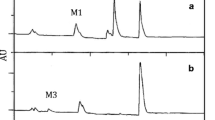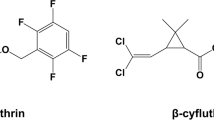Abstract
It is well-known that cadavers may be colonized by microorganisms, but there is limited information if or to what extent these microbes are capable of metabolizing drugs or poisons, changing the concentrations and metabolic pattern of such compounds in postmortem samples. The aim of the present study was to develop a fungal biotransformation system as an in vitro model to investigate potential postmortem metabolism by fungi. Five model drugs (amitriptyline, metoprolol, mirtazapine, promethazine, and zolpidem) were each incubated with five model fungi known to colonize cadavers (Absidia repens, Aspergillus repens, Aspergillus terreus, Gliocladium viride, and Mortierella polycephala) and with Cunninghamella elegans (positive control). Incubations were performed in Sabouraud medium at 25 °C for 5 days. After centrifugation, a part of the supernatants was analyzed by liquid chromatography-tandem mass spectrometry with product ion scanning. Another part was analyzed by full scan gas chromatography-mass spectrometry after extraction and derivatization. All model drugs were metabolized by the control fungus resulting in two (metoprolol) to ten (amitriptyline) metabolites. Of the model fungi, only Abs. repens and M. polycephala metabolized the model drugs: amitriptyline was metabolized to six and five, metoprolol to two and two, mirtazapine to five and three, promethazine to six and nine, and zolpidem to three and four metabolites, respectively. The main metabolic reactions were demethylation, oxidation, and hydroxylation. The presented in vitro model is applicable to studying drug metabolism by fungi colonizing cadavers.
















Similar content being viewed by others
References
Carter DO, Yellowlees D, Tibbett M (2007) Cadaver decomposition in terrestrial ecosystems. Naturwissenschaften 94:12–24
Guarner F, Malagelada JR (2003) Gut flora in health and disease. Lancet 361:512–519
Thorn JL, Gilchrist KB, Sobonya RE, Gaur NK, Lipke PN, Klotz SA (2010) Postmortem candidaemia: marker of disseminated disease. J Clin Pathol 63:337–340
Daldrup T, Huckenbeck W (1984) Significance of the putrefactive bacterium Clostridium sordellii for the determination of age of the cadaver. Z Rechtsmed 92:121–125
Morris JA, Harrison LM, Partridge SM (2006) Postmortem bacteriology: a re-evaluation. J Clin Pathol 59:1–9
Kellerman GD, Waterman NG, Scharefenberger LF (1976) Demonstration in vitro of postmortem bacterial transmigration. Am J Clin Pathol 66:911–915
Paakko P, Nurmi T, Sarkioja T, Hirvonen J, Sutinen S (1986) Post-mortem bacterial culture of bronchial mucus and heart blood in hospital and non-hospital autopsies: effect of morgue time and length of hospitalization. Zentralbl Bakteriol Mikrobiol Hyg B 182:360–371
Baranowski S, Serr A, Thierauf A, Weinmann W, Grosse Perdekamp M, Wurst FM, Halter CC (2008) In vitro study of bacterial degradation of ethyl glucuronide and ethyl sulphate. Int J Legal Med 122:389–393
Helander A, Dahl H (2005) Urinary tract infection: a risk factor for false-negative urinary ethyl glucuronide but not ethyl sulfate in the detection of recent alcohol consumption. Clin Chem 51:1728–1730
Moriya F, Hashimoto Y (1997) Distribution of free and conjugated morphine in body fluids and tissues in a fatal heroin overdose: is conjugated morphine stable in postmortem specimens? J Forensic Sci 42:736–740
Yajima D, Motani H, Kamei K, Sato Y, Hayakawa M, Iwase H (2006) Ethanol production by Candida albicans in postmortem human blood samples: effects of blood glucose level and dilution. Forensic Sci Int 164:116–121
Robertson MD, Drummer OH (1995) Postmortem drug metabolism by bacteria. J Forensic Sci 40:382–386
Schwabe U, Paffrath D (2009) Arzneiverordnungsreport. Springer, Berlin
Ishii K, Hitosugi M, Kido M, Yaguchi T, Nishimura K, Hosoya T, Tokudome S (2006) Analysis of fungi detected in human cadavers. Leg Med (Tokyo) 8:188–190
Hitosugi M, Ishii K, Yaguchi T, Chigusa Y, Kurosu A, Kido M, Nagai T, Tokudome S (2006) Fungi can be a useful forensic tool. Leg Med (Tokyo) 8:240–242
Hawksworth DL, Wiltshire PE (2011) Forensic mycology: the use of fungi in criminal investigations. Forensic Sci Int 206:1–11
Tibbett M, Carter DO (2003) Mushrooms and taphonomy: the fungi that mark woodland graves. Mycologist 17:20–24
Carter DO, Tibbett M (2003) Taphonomic mycota: fungi with forensic potential. J Forensic Sci 48:168–171
Wackett LP, Gibson DT (1982) Metabolism of xenobiotic compounds by enzymes in cell extracts of the fungus Cunninghamella elegans. Biochem J 205:117–122
Asha S, Vidyavathi M (2009) Cunninghamella—a microbial model for drug metabolism studies—a review. Biotechnol Adv 27:16–29
Zhang D, Yang Y, Leakey JE, Cerniglia CE (1996) Phase I and phase II enzymes produced by Cunninghamella elegans for the metabolism of xenobiotics. FEMS Microbiol Lett 138:221–226
Ma B, Huang HH, Chen XY, Sun YM, Lin LH, Zhong DF (2007) Biotransformation of metoprolol by the fungus Cunninghamella blakesleeana. Acta Pharmacol Sin 28:1067–1074
Moody JD, Freeman JP, Fu PP, Cerniglia CE (2002) Biotransformation of mirtazapine by Cunninghamella elegans. Drug Metab Dispos 30:1274–1279
Zhang D, Evans FE, Freeman JP, Duhart B Jr, Cerniglia CE (1995) Biotransformation of amitriptyline by Cunninghamella elegans. Drug Metab Dispos 23:1417–1425
Bjornstad K, Helander A, Hulten P, Beck O (2009) Bioanalytical investigation of asarone in connection with Acorus calamus oil intoxications. J Anal Toxicol 33:604–609
Sauvage FL, Saint-Marcoux F, Duretz B, Deporte D, Lachatre G, Marquet P (2006) Screening of drugs and toxic compounds with liquid chromatography-linear ion trap tandem mass spectrometry. Clin Chem 52:1735–1742
Bonfiglio R, King RC, Olah TV, Merkle K (1999) The effects of sample preparation methods on the variability of the electrospray ionization response for model drug compounds. Rapid Commun Mass Spectrom 13:1175–1185
Meyer MR, Peters FT, Maurer HH (2010) Automated mass spectral deconvolution and identification system for GC-MS screening for drugs, poisons, and metabolites in urine. Clin Chem 56:575–584
Doherty B, Rodriguez V, Leslie JC, McClean S, Smyth WF (2007) An electrospray ionisation tandem mass spectrometric investigation of selected psychoactive pharmaceuticals and its application in drug and metabolite profiling by liquid chromatography/electrospray ionisation tandem mass spectrometry. Rapid Commun Mass Spectrom 21:2031–2038
Vajta S, Thenot JP, de Maack F, Devant G, Lesieur M (1988) Thermospray liquid chromatography tandem mass spectrometry: application to the elucidation of zolpidem metabolism. Biomed Environ Mass Spectrom 15:223–228
Klupsch F, Houssin R, Humbert L, Imbenotte M, Henichart JP, Lhermitte M (2006) Major metabolites of zolpidem: expeditious synthesis and mass spectra. Chem Pharm Bull (Tokyo) 54:1318–1321
Acknowledgments
Jorge Martinez thanks DAAD for the support of this project and the Gesellschaft für Toxikologische und Forensiche Chemie (Society of Toxicological and Forensic Chemistry, GTFCh) for providing the travel fund to present part of this work at the 2011 SOFT-TIAFT Meeting in San Francisco-California. The authors further thank Dr Daniela Remane and Dr Christoph Sauer for their assistance with the preparation of the manuscript.
Author information
Authors and Affiliations
Corresponding author
Electronic supplementary material
Below is the link to the electronic supplementary material.
ESM 1
(PDF 1.21 MB)
Rights and permissions
About this article
Cite this article
Martínez-Ramírez, J.A., Voigt, K. & Peters, F.T. Studies on the metabolism of five model drugs by fungi colonizing cadavers using LC-ESI-MS/MS and GC-MS analysis. Anal Bioanal Chem 404, 1339–1359 (2012). https://doi.org/10.1007/s00216-012-6212-3
Received:
Revised:
Accepted:
Published:
Issue Date:
DOI: https://doi.org/10.1007/s00216-012-6212-3




